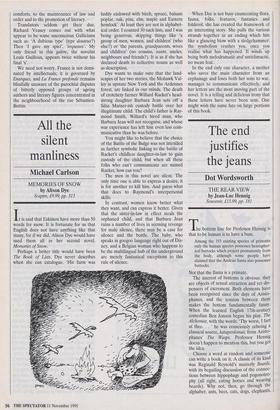All the silent manliness
Michael Carlson
MEMORIES OF SNOW by Alison Dye Sceptre, f9.99, pp. 313 It is said that Eskimos have more than 50 words for snow. It is fortunate for us that English does not have anything like that many, for if we did, Alison Dye would have used them all in her second novel, Memories of Snow.
Perhaps a better title would have been The Book of Lists. Dye never describes when she can catalogue. 'His farm was lushly endowed with birch, spruce, balsam poplar, oak, pine, elm, maple and Eastern hemlock'. At least they are not in alphabet- ical order. I counted 30 such lists, and I was being generous, skipping things like 'a group of men, women, and children' (who else?) or 'the parents, grandparents, wives and children' (no cousins, aunts, uncles, neighbours and friends?). It is as if she has declared death to collective nouns as well as description, Dye wants to make sure that the land- scapes of her two stories, the Mohawk Val- ley in upstate New York and the Ardennes forest, are linked in our minds. The death of crotchety farmer Willard Racket's head- strong daughter Barbara Jean sets off a Silas Marner-ish custody battle over her illegitimate child. The child's father is Ray- mond Smith, Willard's hired man, who Barbara Jean will not recognise, and whose war experience has left him even less com- municative than he was before.
You might like to believe that the choice of the Battle of the Bulge was not intended as further symbolic linking to the battle of Racket's childless daughter-in-law to gain custody of the child, but when all these folks who can't communicate are named Racket, how can you?
The men in this novel are silent. The only time one is able to express a desire, it is for another to kill him. And guess what that does to Raymond's interpersonal skills.
In contrast, women know better what they want, and can express it better. Given that the sister-in-law in effect steals the orphaned child, and that Barbara Jean ruins a number of lives in seeming revenge for male silence, there may be a case for silence and the bottle. The baby, who speaks in googoo language right out of Dis- ney, and a Belgian woman who happens to be the multilingual hub of the underground are merely fantastical exceptions to this rule of silence. When Dye is not busy enumerating flora, fauna, folks, features, fantasies and folderol, she has created the framework of an interesting story. She pulls the various strands together in an ending which hits like a glancing blow with a sledgehammer: the symbolism crushes you, once you realise what has happened. It winds up being both melodramatic and anticlimactic, no mean feat.
In the end only one character, a mother who saves the main character from an orphanage and loses both her sons to war, manages to communicate effectively, and her letters are the most moving part of the novel. It is a telling and delicious irony that these letters have never been sent. One might wish the same fate on large portions of this book.


















































































 Previous page
Previous page